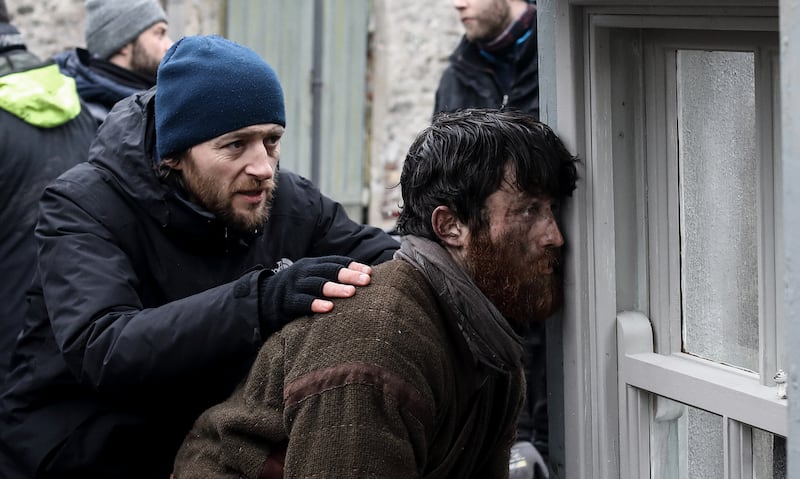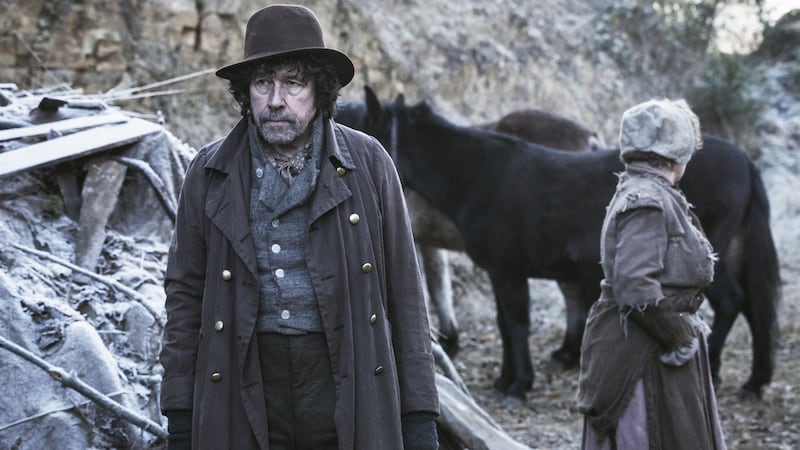During the 1990s, Stephen Rea was approached about a drama based on the Great Famine. The project did not come to pass. "Some American producer said the script is very heavy – couldn't we lighten it?" recalls the actor. "And my agent at the time said: 'How are we going to lighten it? Feed them?'"
Black '47, a new film set against the same catastrophe, and directed by Lance Daly (Kisses, Life's a Breeze), has been a long time coming – 170 years all told.
"There have been a few other famine projects floating around," says the film's producer, Macdara Kelleher. "John Ford was the first person to talk about making a Famine film. Even he never managed to do it."
The idea of a feature film rooted in the Great Famine is almost certainly a good deal more saleable than it might have been two decades ago, lightened or not. Recent years have seen a revival in Famine-related art and media, culminating in Coming Home: Art and the Great Hunger, the world's largest collection of art relating to the Famine, opening in Dublin on loan from Ireland's Great Hunger Museum at Quinnipiac University in Connecticut last July.
It's not a spaghetti western; it's a potato western. There's some similarity
"There's been more and more interest and research, particularly since the 150th anniversary in the mid-90s," says Niamh O'Sullivan, the exhibition's curator, and one of several historical consultants who advised on Black '47. "The Great Hunger museum opened six years ago in America and did very well. Since we brought Coming Home to Dublin Castle, I've been absolutely astonished by the reaction. We've had nearly 85,000 people see it so far. And there's no sign of the numbers abating.
“One of the things that’s interesting about what we’ve done and what Lance has done is that you get a much richer understanding of the time. Before, we just had history telling us what the Famine was about. Now we have novelists and poets. We have architects looking at workhouses and psychologists talking about the trauma. It’s now a multi-disciplinary subject, and there’s extraordinarily interesting work coming out of that.”
Representing the Great Famine remains a daunting enterprise. The sheer scale of the social disaster – a million deaths by starvation and another million forced to emigrate during the years between 1845 and 1849 – ought to be impossible to dramatise. Set in Connemara in 1847, Lance Daly's drama unfolds as a classic revenge cycle in which Feeney, a Connaught Ranger (played by James Frecheville), returns from war to discover that his mother has died in the Famine and that his brother has been hanged by the British. With nothing left to lose, he embarks on a campaign of retribution against the authorities and the ascendancy. An equally determined Hannah (Hugo Weaving) is dispatched to track Feeney down. Irish actors Barry Keoghan, Sarah Greene, Stephen Rea and Moe Dunford round off the cast.

Daly has cited Clint Eastwood's Unforgiven, Paul Schrader's Rolling Thunder and Bergman's The Virgin Spring as cathartic precedents.
“The joke has been made,” says the film-maker. “It’s not a spaghetti western; it’s a potato western. There’s some similarity. There are hats and horses in our film and the period it’s set in is 25 years before the classic western period. But I don’t know how much of a western it is, because so much of the western is about power and the frontier and American cultural icons. The western revises the history of the west and the killing of the natives, so this is almost an anti-western in that it is told from the side of the Apaches.”
“You have a narrative that takes you through the whole world of the Famine,” adds Rea, who steals the picture as the wily, gallows-humoured guide. “It’s a guy wanting to have revenge. That’s crucial. It isn’t just about victims. It’s about someone saying: well, I’m not a fucking victim. That’s why it works.”
Genre allowed a way into the material, but only after a wealth of historical detail was considered. The screenplay, which is credited to four writers (including PJ Dillon, Pierce Ryan, Eugene O'Brien and Lance Daly), was carefully revised to allow the plot to be true to the period.
‘Loads of homework’
“We did loads of homework,” says Daly. “We spoke to a lot of historians. We looked at all the available paintings and all the drawings. There isn’t a lot. But we looked at the archive at Quinnipiac museum. They have the biggest visual archive so that was a constant resource. There are little things in the film where I wasn’t quite able to get to where I wanted in terms of historical accuracy. We can’t know for sure what the accent sounded like or what colour something was. But it’s as true to the time as much as it can be. In terms of the social structure and power structure, the position of the judge and the landowner is as close as we could get it. The historians we’ve talked to are very positive. I was at a screening with Breandán Mac Suibhne where there was a priest that stood up the audience – he had done a lot of his own research on the Famine in west Cork – and he said: ‘I think this film is too violent; it was a sad and quiet time of people dying.’ And Breandán said: ‘No, you’re wrong, it was a violent time. It was a violent time between families. It was a violent time in society.’”
Daly and his production colleagues worked closely with Niamh O'Sullivan in order to create a Famine aesthetic, poring over such famous sketches as the contemporaneous sequence that ran in Illustrated London News under the heading "Condition of Ireland – Illustrations of the new Irish Poor-Law" in December 1849. That sequence includes such infamous tableaux as "Miss Kennedy distributing clothing at Kilrush" and "Village of Moveen", in which the roofs of an entire settlement have been tossed so as to render the houses uninhabitable.
I don't think it's possible to dramatise with sincerity or honesty the suffering that happened at that time
"I was contacted fairly early on in the process," says Niamh O'Sullivan. "Because I've done a lot of research into the visuality, if you like, of the Famine. Lance and his team were obviously very interested in the visuals: how the landscape looked, how people were dressed. When you see the early sequences of the film, they have that sepia look that you got with the Illustrated London News because of course there are no known photographs of the Famine. Photography was just in its infancy. And art had great difficulty pictorialising an epic catastrophe such as the Famine. So it was really through the illustrations in the Pictorial Times and the Illustrated London News that people around the world actually learned about the Famine. Those publications had a huge circulation. The Illustrated Times had sales of more than 100,000 at the time."
Apocalyptic landscape
O'Sullivan is quietly confident that Black '47 has captured the apocalyptic landscape of An Gorta Mór: "I wouldn't be so bold as to say that it is the definitive look of the Famine because I am quite sure that other people at other times will come up with other takes on it that will be as interesting and as challenging," she says. "But I think it's a fantastic rendition. That first 10 or 15 minutes is probably as much detail as people could take. If you had kept that up for 100 minutes people would have been deadened by it. The fact that the narrative goes into a different register makes the early part work."

That bravura opening sequence and the subsequent gear-change indicates the director’s careful approach to representing the “unrepresentable”.
“I don’t think it’s possible to dramatise with sincerity or honesty the suffering that happened at that time,” says Daly. “I think that there’s something weirdly perverse about trying to do so and I certainly don’t think you can do it as entertainment. We did find it hard. Sarah starved herself for months for the film. Not even as someone who is supposed to be starving to death but just as someone who hasn’t eaten. She was disappearing but then put on the big skirt and the floppy clothes and the effect was kind of lost anyway. So there was never an intention to stage something that would capture was what is it like to see your children starve. This is a revenge story. It’s about the politics of the time. It’s about the relationships of the time. It’s not about how skinny the actors could get. For me, that’s something to be avoided in the same way I’d avoid gratuitous violence.”
Black '47 has already been snapped up by IFC, the US handlers for Personal Shopper and Boyhood, for distribution across North America. Irish Central, the Irish-American website, has characterised the film as an Irish Inglourious Basterds, and welcomed the upcoming release as a chance for "the Irish to wreak havoc on Perfidious Albion". Quite.
Black '47 is on general release






















